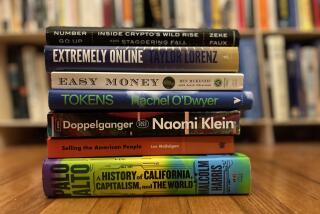Awash in the digital typhoon
- Share via
If your memory of the last decade is a pixelated blur of dot-com schemes spawning countless millionaires, then revisiting the rise of the digital era through its most celebrated publication should bring events sharply back into perspective. In “Wired: A Romance,” Gary Wolf offers a studied rather than sensational journey through the detritus of the ‘90s techno explosion, the magazine’s pivotal role in it and its maverick cast of characters. From the first issue in early 1993, it was clear that the magazine had a far loftier ambition -- to bring technology into the mainstream -- than becoming an eye-catching fanzine for futurists and techno-libertarians.
Unlike Michael Wolff’s personal boom-to-dust Internet story, uproariously told in “Burn Rate,” and others indulging in the high-octane flag-planting days of the Internet, Wolf, a contributing editor at the magazine, doesn’t dwell on those fresh out of MBA school hyperventilating over the notion of getting very rich, very fast. The Wired story isn’t about getting rich or famous. It predates the instant celebrity of reality TV and Wall Street’s spurious addiction to “pump-and-dump” and settles in to render an exhilarating era of technological change. In answer to the question “Why Wired?” in the debut issue, Louis Rossetto, the magazine’s enigmatic founder, wrote, “Because the Digital Revolution is whipping through our lives like a Bengali typhoon -- while mainstream media is still groping for the snooze button.” Rossetto and his followers recognized that a transformational digital revolution was underway and they were the ragtag vanguard setting its agenda. Although Rossetto’s romance with the magazine he founded ended acrimoniously in 1998 with his unfinished dreams pitted against a cabal of cash-hungry stakeholders, it begins like all great business stories, with an idea and an unwavering determination to breathe life and relevance into that idea.
The author sets the scene early on for what Rossetto dreamed of creating. While trying to recruit Kevin Kelly, now Wired’s editor at large, Rossetto explained that Wired should be a message mailed back to the present from the future. Kelly immediately understood: “It would land at people’s feet and they would stare and wonder and not be able to stop themselves from picking it up. They would be perplexed, fascinated, revolted, mesmerized.” This kind of unfettered ambition is why Wolf’s book and others that explore the magnetic personalities behind building powerful brands are so alluring.
The Wired story starts long before the first issue was snatched up at the MacWorld conference in January 1993. Rossetto and his partner, Jane Metcalfe, were scraping by in Amsterdam in the ‘80s working on the fringes of publishing -- bohemian expats drawn to each other and looking to flex their intellectual curiosity. Rossetto had been working on tech-related newsletters and niche finance publications in Europe -- experimenting at the forefront of the desktop publishing revolution.
Metcalfe, a vivacious Southerner from Louisville, Ky., came up with the name for Wired, and the couple’s early struggle to find believers, raise cash and build a prototype is an appealing part of Wolf’s exploration. It’s one of the lesser-visited periods of an otherwise very public story.
Once Wired was unleashed, there was no end to its documentation by curious, sometimes envious journalists who watched on the sidelines as the magazine became the go-to journal for all that was unimaginable about technology. When Rossetto described the launch of HotWired in 1994 as “the live, twitching, real-time nervous system of the planet,” Newsweek responded, “Is HotWired, Wired magazine’s Web site, too cool to live?” Which is why the book also disappoints. The author opts for an impassive third-party detachment toward his characters. With few direct quotes and just a scattering of e-mail excerpts and remembrances, Wolf never fully draws the reader into the moment. “Wired: A Romance” becomes rather “Wired: An Agreeable Date but No Kiss.”
John Plunkett, Wired’s design architect, occasionally comes close with some unabashed candor to recalling what an emotional cauldron it was. For a time Wolf was HotWired’s executive editor, so he had a ringside seat. There’s no doubt he’s done his homework with ample nostalgic references to early Wired subjects such as young -- and then unknown -- entrepreneurs like Netscape co-founder Mark Andreessen and cryptographers like Phil Zimmerman, and early landmarks, like the first banner ads, selling on HotWired for $10,000.
The number of entertaining e-mail debates and excerpts that do make the cut bring us closer to the spirit of the time -- many questioning what the Internet meant back then. One debate, copied to everyone in the company, circled around the issue of user registration at HotWired. Purists argued that any sort of imposition was anathema to the free spirit of the then fledgling World Wide Web. Rossetto thought otherwise. Ian McFarland, a 22-year-old programmer, kept the debate going long after others had given up:
McFarland: “The metaquestion then becomes: Is Wired progressive, or has it become merely the marketing of the progressive?”
Rossetto: “The metaquestion is: what are you smoking? Do you have another business model that will allow us to pay your and everyone else’s salary while supporting your absurdly abstract sense of what privacy really means?”
We’re taken on an ambitious tour of Wired’s rambling empire, starting with the remarkable success of the magazine, a litany of idiosyncratic, money-losing sites under the umbrella of HotWired, a failed attempt to bring Wired’s libertarian politics to television by way of a series called “The Netizen,” and a book division, which cleverly repackaged much of the magazine’s content. We discover there’s trouble brewing in London on how to position Wired’s first overseas edition. With the two cultures evidently poles apart, several U.S. editors spent months in the U.K. trying to bridge the gap.
Wired’s media expansion between 1994 and 1996 was in full swing. “You’re only hot once,” Rossetto explained at the time. A high-profile media brand, no matter how precariously assembled, might attract the attention of Wall Street. After Netscape’s spectacular offering in the summer of 1995, everyone began lining up to take their chances.
But, as Wolf remarks later in the book, when Rossetto is ready to lose everything and wreck a multimillion-dollar buyout for the sake of his principles, it’s evident that his need to expand was not driven by his need to become rich. Wolf writes: “He seemed interested only in exercising his talents in inventing a new medium. His claims about Wired as a billion-dollar company failed to disguise motivations that had nothing to do with money.” Wolf devotes the latter part of his story to carefully reconstructing the events and boardroom manipulations that led to Wired’s two humiliating attempts at going public, to near bankruptcy and its ultimate breakup and sale. Conde Nast’s corporate parent bought the magazine in 1998 for about $90 million, and Lycos later bought the online division for considerably more in a bitter and prolonged stock deal.
It’s the lasciviousness of these final months of haggling that those down in the company trenches, still wielding the tools and slogans of the digital revolution, will be most dismayed to read. After the dust had settled, Andrew Anker, HotWired’s chief executive and a former investment banker, told a group of his charges: “What is this, ‘Sesame Street’? Every man for himself means every man for himself.” He jovially explained the first rules of business, at least his business, to those gathered. “The people at the table grab as much as they can.”
Although now a wealthy man with time to reflect, Rossetto’s media dream was never fully realized. The bigger his ambitions, the more subjugated he became in finding the money to fund them. Once financiers had put sufficient skin in the game, they would not risk leaving it in the hands of its brilliant but willful creator. Wolf acknowledges that he has told only part of the story here. The full veracity of events will only come out if Louis Rossetto ever steps forward with his own words.
More to Read
Sign up for our Book Club newsletter
Get the latest news, events and more from the Los Angeles Times Book Club, and help us get L.A. reading and talking.
You may occasionally receive promotional content from the Los Angeles Times.










